Sep 28, 2016 | IIASA Network
By Daniel McMurray, BA LLB MIL Global Event Lead – Impact Hub, Managing Director & Global Head of Communications – Enterprise IQ Pty Ltd
“It is paradoxical, yet true, to say, that the more we know, the more ignorant we become in the absolute sense, for it is only through enlightenment that we become conscious of our limitations. Precisely one of the most gratifying results of intellectual evolution is the continuous opening up of new and greater prospects”.
– Nikola Tesla
It is hard not to feel that we live at a pivotal moment in history, with the world racing toward an epochal crossroad.
In one direction lies the path of reason, science, community and progress. A world where growing systemic challenges like climate change, resource scarcity, overpopulation, inequality, and environmental degradation can be addressed through logic, evidence, and rational, creative, and collaborative action. Where the ingenuity, collective genius, and relentless optimism of humanity can resolve complex problems such as poverty, disease, and ecological collapse, creating abundance of energy, health, education and well-being for all.
In the other direction, lies a different path. One of regression, unreason, and parochialism. A fact-free, fearful and frightening world of separation, science denialism, and superstition, ruled over by demagogues offering glib, unworkable solutions, convenient scapegoats to blame, and soothing illusory retreat into fragmented tribal realms.
Which path we collectively choose to follow will determine the trajectory of the 21st century and beyond. Will we choose the enlightened path of working together collectively, collaboratively, and consciously for the greater good? Or will we choose the path of darkness, disintegrating into unconscious, unreasonable and irrational behavior that hastens systemic collapse?
At such a pivotal moment, the choice of “New Enlightenment” as the theme for the recent European Forum Alpbach was a timely, prescient and crucial framing.
Attending the forum with my European-based colleagues from Impact Hub – a globally connected network of social entrepreneurs, innovators, and change-makers as official partners for the event – inspired hope that the path of enlightenment, reason and collaborative action is fundamentally achievable.
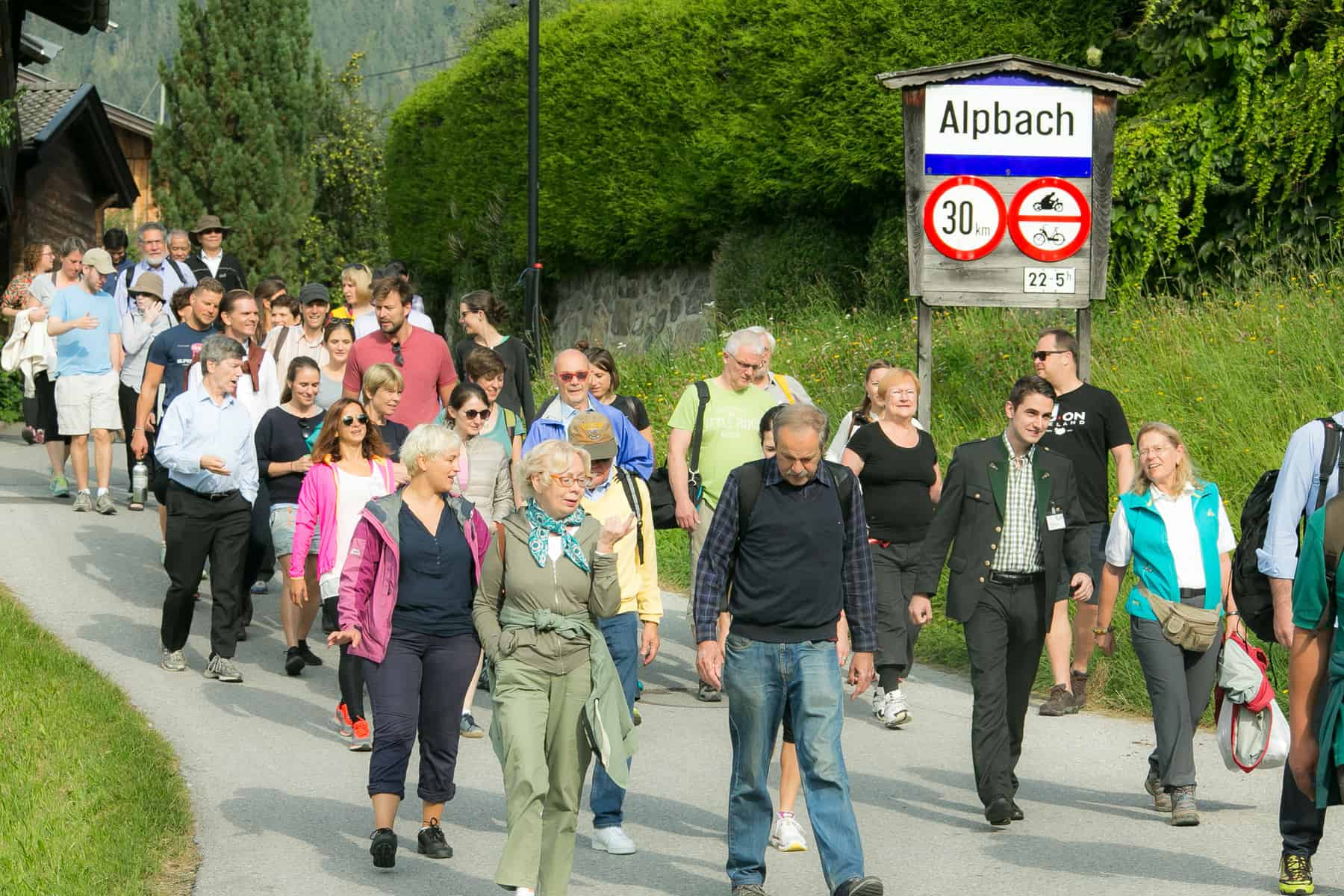
Members of the Alpbach Laxenburg Group and Impact Hub hike in Alpbach, Austria in August 2016. © Matthias Silveri | IIASA
One of the highlights of the event for our contingent was a facilitated hike into the Tyrolean alps with Pavel Kabat (Director General & CEO of IIASA) and other key thought leaders from the Alpbach Laxenburg Group – including Jeffrey Sachs (Director of The Earth Institute from Columbia University), Tarja Halonen (the former President of Finland), Björn Stigson (former President of the WBCSD), Justin Yifu L in (Director of the Centre for New Structural Economics at Peking University), Pascal Lamy (former Director-General of the WTO), and many more cross-sectoral leaders from business, government, NGOs and civil society.
Gathered together in the scenic environs of the Boglalm Chalet, this diverse and eclectic group focused our discussion around how we can work together to achieve the Sustainable Development Goals.
Professor Sachs’ definition of an “entrepreneur” struck a chord. He described entrepreneurs as those with the vision to take elements from diverse sources, creatively combining and re- combining in new ways, key insights from different sectors, research fields, technologies, or existing systems to present a new solution or way of thinking.
In that group, representing a mix of the established elite and the challengers of tomorrow, the old and the new from business, government, science, social enterprise, and civil society, it was refreshing to feel the positive energy and inspired thinking that can come from embracing and making space for an open, cross -pollination of ideas.
It brought to mind a universal truth – that humanity is at its best when we work together collaboratively, breaking down barriers, dissolving silos of thought and entrenched interests and, like Professor Sachs’ concept of real entrepreneurship, combining ideas in new, innovative and creative ways. The path of enlightenment is not the domain of any one group. Political leaders can’t fix things alone – lacking the power, methodologies, community currency, and instruments required. They need business leaders, scientists, innovators, and change-agents from the social sector and civil society to bridge the gaps in dialogue, bring fresh insights and recombine them in radically new ways.
As Albert Einstein famously said, “We cannot solve our problems with the same level of thinking that created them”. The path of enlightenment can only be reached through collaborative action. It is a conscious choice and one that we must come together to choose in order to avert catastrophe.
“Really, the only thing that makes sense is to strive for greater collective enlightenment”.
Elon Musk
Note: This article gives the views of the author, and not the position of the Nexus blog, nor of the International Institute for Applied Systems Analysis.
Aug 23, 2016 | Science and Art, Science and Policy
Gloria Benedikt was born to dance. She started at the age of three and since the age of 12 she has been training every day—applying the laws of physics to the body. But with a degree in government and an interest in current affairs, Benedikt now builds bridges between these fields to make a difference, as IIASA’s first science and art associate.
Conducted and edited by Anneke Brand, IIASA science communication intern 2016.
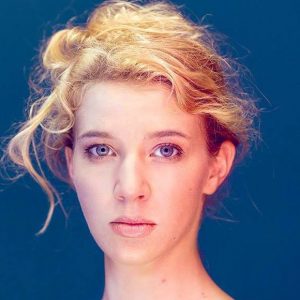
Gloria Benedikt © Daniel Dömölky Photography
When and how did you start to connect dance to broader societal questions?
The tipping point was when I was working in the library as an undergraduate student at Harvard University. I had to go to the theater for a performance, and thought to myself: I wish I could stay here, because there is more creativity involved in writing a paper than in going on stage executing the choreography of an abstract ballet. I realized that I had to get out of ballet company life and try to create work that establishes the missing link between ballet and the real world.
To follow my academic interest, I could write papers, but I had another language that I could use—dance—and I knew that there is a lot of power in this language. So I started choreographing papers that I wrote and rather than publishing them in journals, I performed them. The first work was called Growth, a duet illustrating how our actions on one side of the world impact the other side. As dancers we need to concentrate and listen to each other, take intelligent risks and not let go. If one of us lets go, we would both fall on our faces.
What motivated you make this career change?
We as contemporary artists have to redefine our roles. In recent decades we became very specialized, which is great, but we lost our connection to society. Now it’s time to bring art back into society, where it can create an impact. I am not a scientist. I don’t know exactly how the data is produced, but I can see the results, make sense of it and connect it to the things that I am specialized in.
How did you get involved with IIASA?
I first started interdisciplinary thinking with the economist Tomáš Sedláček who I met at the European Culture Forum 2013. A year later I had a public debate with Tomáš and the composer Merlijn Twaalfhoven in Vienna. Pavel Kabat, IIASA Director General and CEO, attended this and invited me to come to IIASA.
What have you done at IIASA so far?
For the first year at IIASA I created a variety of works to reach out to scientists and policymakers and with every work I went a step further. This year, for the first time I tried to integrate the two groups by actively involving scientists in the creation process. The result, COURAGE, an interdisciplinary performance debate will premiere at the European Forum Alpbach 2016. In September, I will co-direct a new project called Citizen Artist Incubator at IIASA, for performing artists who aim to apply artistic innovation to real-world problems.
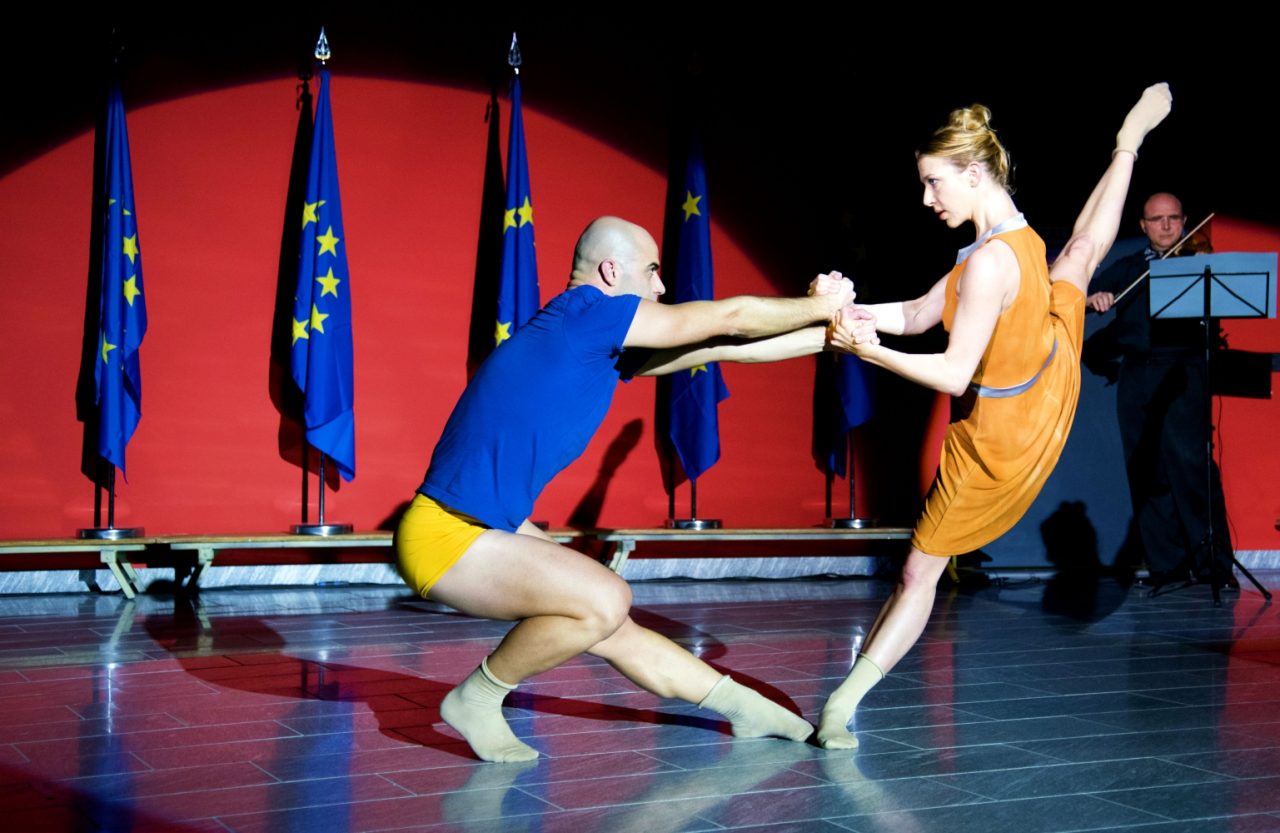
Gloria and Mimmo Miccolis performing Enlightenment 2.0 at the EU-JRC. The piece was specifically created for policymakers. It combined text, dance, and music, and reflected on art, science, climate change, migration and the role of Europe in it. © Ino Lucia
How do scientists react to your work?
The response to my performances at the European Forum Alpbach 2015 and the European Commission’s Joint Research Centre (EU-JRC) was extremely positive. It was amazing to see how people reacted—some even in tears. Afterwards they said that they didn’t understand what I was trying to say for the past two days, but the moment that they saw the piece, they got it. Of course people are skeptical at first—if they were not, I will not be able to make a difference.
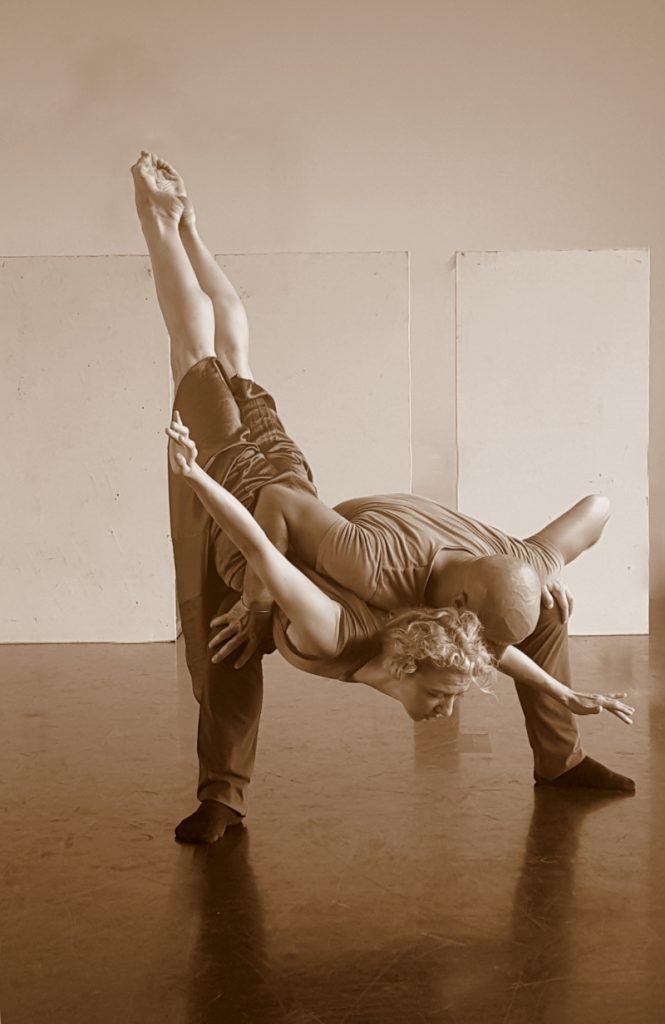
Gloria and Mimmo Miccolis rehearsing at Festspielhaus St. Pölten for COURAGE which will premiere at the European Forum Alpbach 2016.
What are you trying to achieve?
I’m trying to figure out how to connect the knowledge of art and science so that we can tackle the problems we face more efficiently. There are multiple dimensions to it. One is trying to figure out how we can communicate science better. Can we appeal to reason and emotion at the same time to win over hearts and minds?
As dancers we can physically illustrate scientific findings. For instance, in order to perform certain complicated movements, timing is extremely critical. The same goes for implementation of the Sustainable Development Goals.
Are you planning on doing research of your own?
At the moment I am trying something, evaluating the results, and seeing what can be improved, so in a way that is a type of research. For instance, some preliminary results came from the creation of COURAGE. We found that if we as scientists and artists want to work together, both parties will have to compromise, operate beyond our comfort zones, trust each other, and above all keep our audience at heart. That is exactly what we expect humanity to do when tackling global challenges. We have to be team players. It’s like putting a performance on stage. Everyone has to work together.
More information about Gloria Benedikt:
Benedikt trained at the Vienna state Opera Ballet School, and has a Bachelor’s degree in Liberal Arts from Harvard University, where she also danced for the Jose Mateo Ballet Theater. Her latest works created at IIASA will be performed at the European Forum Alpbach 2016 as well as the International Conference on Sustainable Development in New York.
www.gloriabenedikt.com
Fulfilling the Enlightenment dream: Arts and science complementing each other
Note: This article gives the views of the interviewee, and not the position of the Nexus blog, nor of the International Institute for Applied Systems Analysis.
Aug 19, 2016 | Science and Policy, Young Scientists
By Anneke Brand, IIASA science communication intern 2016.
For Malgorzata (Gosia) Smieszek it’s all about making sound decisions, and she is not afraid of using unconventional routes in doing so. She applies this rule to various aspects of her fast-paced life. Whether it is taking the right steps in trail running races, skiing or relocating to the Arctic Circle to do a PhD.
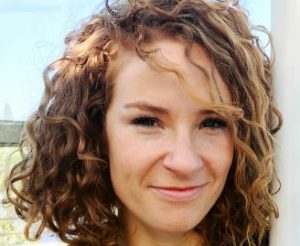
Gosia Smieszek © J. Westerlund, Arctic Centre
Gosia’s passion for the Arctic began to evolve during a conversation with a professor at a time when she was contemplating the idea of returning to academia. “I remember, when he said the word Arctic, I thought: yes, that’s what I want to do. True, before I was interested in energy and environmental issues, but the Arctic was certainly not on my radar. So I went to the first bookstore I found, asked for anything about the North and the lady, after giving me a very confused look, said she might have some photo books. So I left with one and things developed from there.”
In 2013 Gosia joined the Arctic Centre of the University of Lapland in Rovaniemi, Finland. Living there is not always easy, but hey, if you get to see the Northern Lights, reindeers and Santa Claus on a regular basis, it might be worth enduring long times of darkness in winter and endless sunshine in summer. With temperatures averaging −30°C, Rovaniemi is the perfect playground for Gosia.

Running is one of Gosia’s favorite sports. She has competed in a few marathons, but her biggest race to date is the Butcher’s Run, an ultra trail of 83km over the Bieszczady mountains in Poland. Here she is running in the Tatra mountains. © Gosia Smieszek
Gosia grew up in Gliwice, a town in southern Poland, before moving to Kraków where she completed her undergraduate degree in international relations and political science. This was just before Poland’s accession to the EU, so it was the perfect time to pursue studies in this field.
She continued her studies in various locations including Belgium, France, Poland, and Austria. Before continuing her education and later working at the College of Europe, she also gained working experience as a translator at a large printing house in her home town in Poland.
For her PhD Gosia focuses on the interactions between scientists and policymakers, with the aim of enhancing evidence-based decision making in the Arctic Council. Scientific research on the Arctic has been conducted for decades, but “when it comes to translating science into practice it is still a huge challenge―on all possible levels,” she says.
“Scientists and policymakers have their own, very different, universes—with their own stories, goals, timelines, working methods and standards. It is better than in the past, but still extremely difficult to make these two universes meet.”
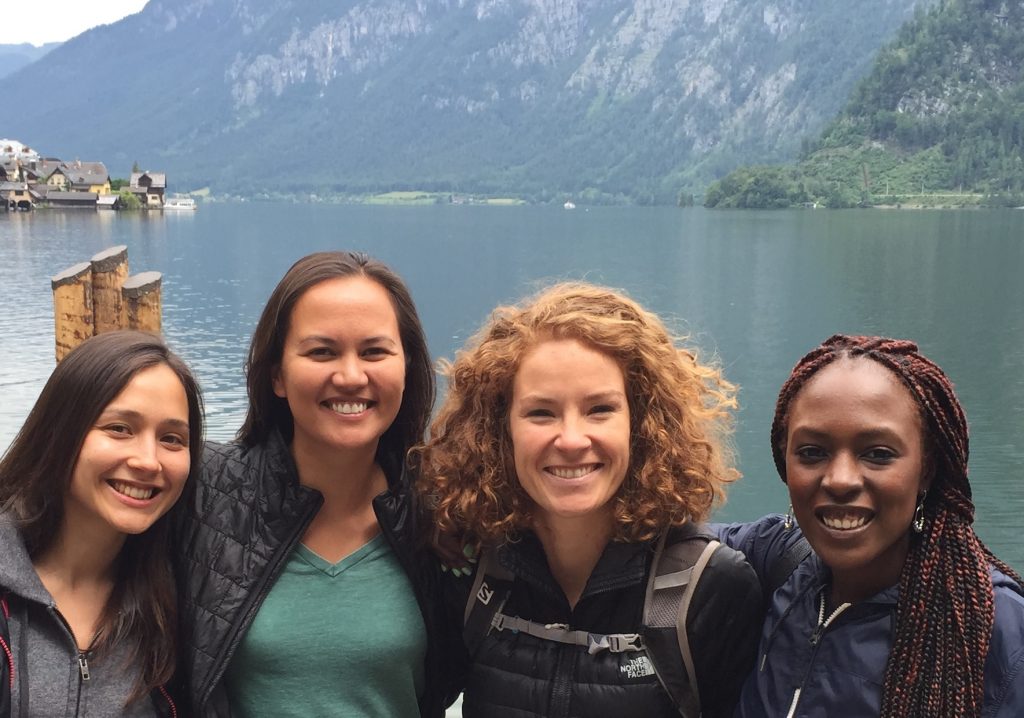
Gosia with fellow YSSPers, Dina, Stephanie and Chibulu during a visit to Hallstadt. © Chibulu Luo
As part of the Arctic Futures Initiative at IIASA, Gosia investigates and maps the structural organization of the Arctic Council and aims to determine the effectiveness of interactions between scientists and policymakers, as well as ways to improve the flow of knowledge and information between them.
Because of the nature of her work, Gosia spends almost half her time away from home, but you will never find her traveling without running shoes, swimming gear, and something to read. Diving, one of her greatest passions, has taken her to amazing places like Cuba and the Maldives, where meeting a whale shark face-to-face topped her list of underwater experiences.
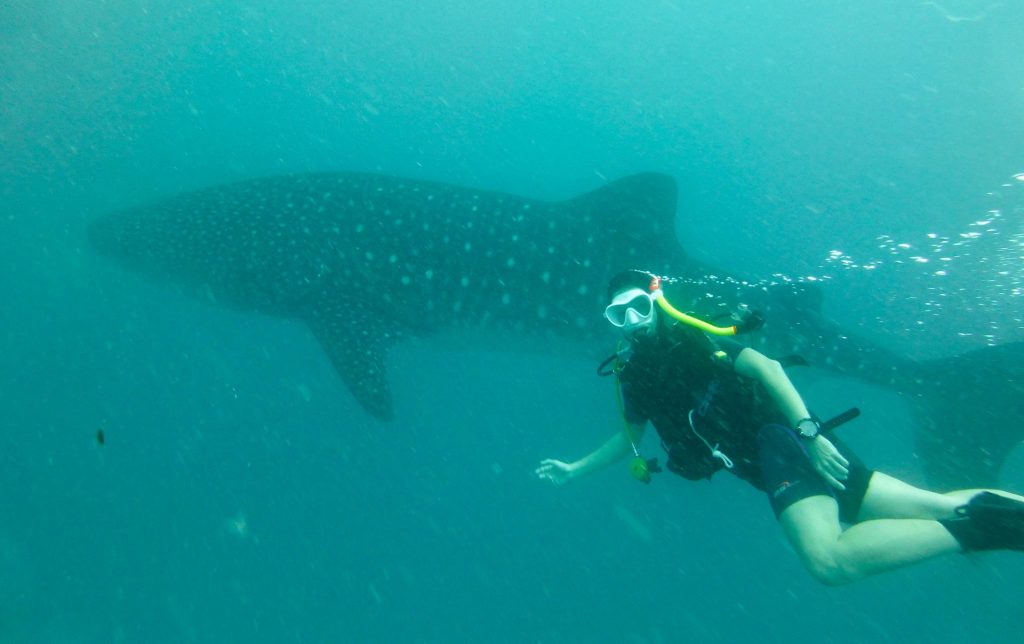
Gosia swimming with a whale shark. © Eiko Gramlich
Gosia is truly hoping to make a difference with her research on science-policy interface. She says: “To me, trying to bridge science and policy is a truly fascinating endeavor. Exploring these two worlds, seeking to understand them and learning their ‘languages’ to enable better communication between them is what drives me in my research. So hopefully we can learn from past mistakes and make things better—this time.”
Note: This article gives the views of the author, and not the position of the Nexus blog, nor of the International Institute for Applied Systems Analysis.
Jul 29, 2016 | Air Pollution, Young Scientists
By Anneke Brand, IIASA science communication intern 2016.
Accidents, lane closures, and congestion all affect the flow of road traffic and harmful emissions from vehicles. Live traffic data allow congestion to be detected more accurately and provide a more precise overview of vehicle emissions at different times and places. In his project for the Young Scientists Summer Program (YSSP), Fabian Heidegger investigates how road traffic affects air pollution in cities, using Vienna and surrounding areas as a case study.
Air pollution is a major problem in Europe and globally. Health impacts of air pollution include a range of respiratory and cardiovascular diseases. “10-20% of Europe’s urban population is exposed to excessive levels of nitrogen dioxide (NO2), along with several other air pollutants. NO2 pollution is highest along busy roads. Technical measures have so far often been circumvented, so cities are looking for other measures to reduce the pollution load. Traffic management has therefore gained interest as a way to reduce air pollution,” says Jens Borken-Kleefeld, Heidegger’s study leader at IIASA.
To calculate the amount of air pollution that cars and other vehicles release into the air, researchers use models that apply various sets of data: traffic networks, where and how far people drive, and emission factors of different vehicle categories. Input data for the model may include how many people live in a certain area, how many of them use cars, where they normally drive, and how many grams of pollutants (such as nitric oxide and NO2 gases) their type of cars emit per kilometer.

Inner city Vienna. © Radub85 | Dreamstime.com
Most of these models rely on average daily traffic data. For Heidegger’s YSSP project, which is related to his PhD work at the University of Natural Resources and Life Sciences in Vienna, he is incorporating real-time data, measured every five minutes, into a traffic simulation model developed by Intelligent Transport Systems Vienna Region. A set of detectors in and around the city record the number and speed of vehicles. In addition, location data from the taxi fleet is incorporated into the traffic simulation. Heidegger can therefore immediately identify adverse traffic conditions like stop-and-go traffic, which has a high impact on emissions. This allows for a more accurate calculation and can help design traffic interventions for improving both traffic flow and air quality.
“In the case of a road closure, local emissions will obviously be lower at the specific road but total emissions for the area could be higher than before when drivers use alternative, longer routes or end up in stop-and-go traffic,” says Heidegger.
In order to understand how these diversions and the displacement of pollutants can affect overall emissions, Heidegger will first determine the emissions per street section, and second, what the effects are of diversions from day-to-day traffic patterns. Together with researchers from the Air Quality and Greenhouse Gases Program at IIASA, Heidegger plans to assess the impact of different intervention scenarios, for example an environmental zone in the city, where only modern cars will be allowed to enter. In a second scenario he will look at the effect of people commuting to Vienna, and a third scenario will explore the consequences of expanding pedestrian zones. The researchers hope that this study will better their understanding of the potential of traffic management to reduce air pollution.
More information
Air Pollution Policy Review 2011-2013
GAINS Model
AIR Program
Note: This article gives the views of the author, and not the position of the Nexus blog, nor of the International Institute for Applied Systems Analysis.
Jun 30, 2016 | Postdoc, Water
By Edward Byers, Postdoctoral Research Scholar, IIASA Water, Energy, and Transitions to New Technologies programs
Scenario analysis, a process for comparing alternative futures, has been a fundamental tool in sustainability and systems research, but less prominent in the water field. Recently, researchers at IIASA have been applying scenario analysis to their modelling capabilities to tackle global water issues.
Last week, a high level group of water experts met at IIASA for the Water Futures and Solutions (WFaS) Stakeholder Focus Group. WFaS is a flagship initiative from IIASA challenged with understanding future water resource issues, and identifying solutions to problems like water scarcity and water access. However, when a recent fast track assessment found that even its most sustainable scenario, would still result in water scarcity in some river basins due to growing demands, researchers realized that fresh thinking was required. So in last week’s meeting, IIASA water researchers were on the search for more sustainable and transformational solutions. The efficacy of these new sustainability scenarios will be tested in IIASA’s new ensemble of global hydrological models and presented in time for the next World Water Forum 2018.
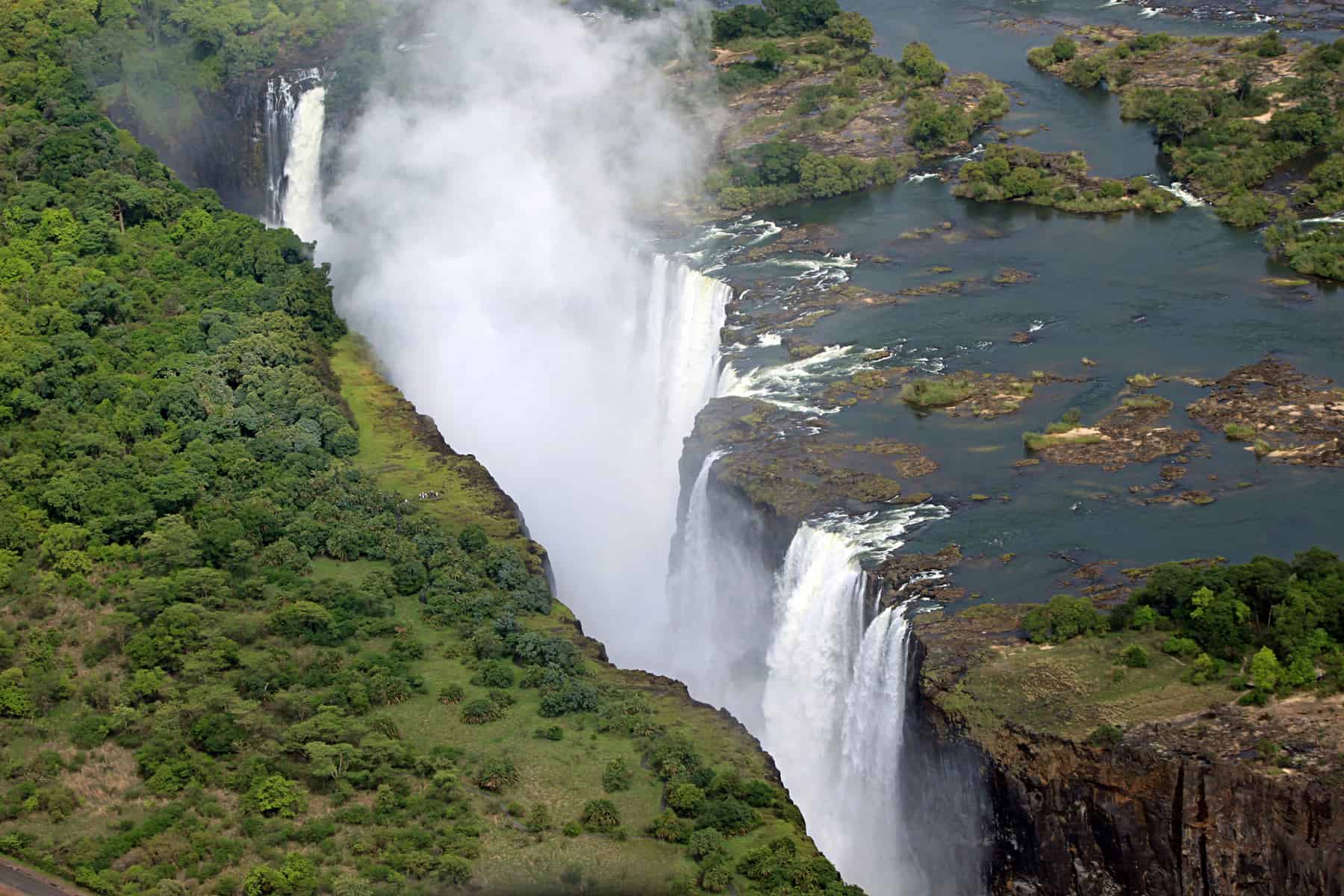
Victoria Falls on the Zambezi River. In the Zambezi basin, water is abundant but there are challenges in getting that water to the people who need it, particularly as the population grows in the future. (cc) Pius Mahimbi | Flickr
The two-day workshop at IIASA hosted 20 international water experts from around the world and across research, government, and development organisations. Modellers from the IIASA water program, myself included, took part in the focus groups with the experts, discussing how to represent in our models complex interactions that occur in transboundary river basins as well as for key interactions with other sectors such as energy and agriculture.
Our discussions on the Zambezi, the Indus, and the Yellow river basins will contribute to broader understanding of the development challenges in three different parts of the world –not just along the rivers, but throughout the entirety of the river basins and the populations and ecosystems that they support. For example, the Indus basin is extremely water scarce and is expected to be further depleted due to melting of the upstream glaciers. In the Zambezi basin, in contrast, water is abundant, but there are significant political and economic challenges to sustainably providing access to a population of 38 million people that is expected to double within one generation.
Similarly, our sectoral discussions on energy, food, economics, and ecosystems will improve our model representations of sectors that may be substantially different by 2050, such as the energy sector. This is particularly important for demonstrating how the benefits of water security unlock other benefits for development challenges, such as health, food security, gender equality, and education.
Identifying, quantifying and communicating these well-recognized, inter-dependent benefits can be key to unlocking the investment in solutions. Our work with the experts focused primarily on Sustainable Development Goal 6, the Clean Water and Sanitation Access goal, with a view to identifying co-benefits for other goals. Having received much useful information and positive feedback from our stakeholders, the challenge now is to integrate this into our models and scenario narratives, so that we can demonstrate on a global scale the benefits of water security not as a development target to be attained, but as one of the fundamental drivers of sustainable development. With growing populations and intensifying impacts of climate change, challenges for water security will continue long beyond the Sustainable Development Goals for 2030. Meeting these targets is just the first step of the pathway to long-term water security.

Participants in the 2nd Water Futures and Solutions Scenario Focus Group Meeting. ©Phillip Widhalm | IIASA
The Water Futures and Solutions Initiative (WFaS) was launched by IIASA, UNESCO/UN-Water, the World Water Council (WWC), the International Water Association (IWA), and the Ministry of Land, Infrastructure and Transport (MOLIT) of the Republic of Korea, and has been supported by the government of Norway, the Asian Development Bank, and the Austrian Development agency. More than 35 organizations contribute to the scientific project team, and an additional 25 organizations are represented in stakeholder groups.
Note: This article gives the views of the author, and not the position of the Nexus blog, nor of the International Institute for Applied Systems Analysis.












You must be logged in to post a comment.